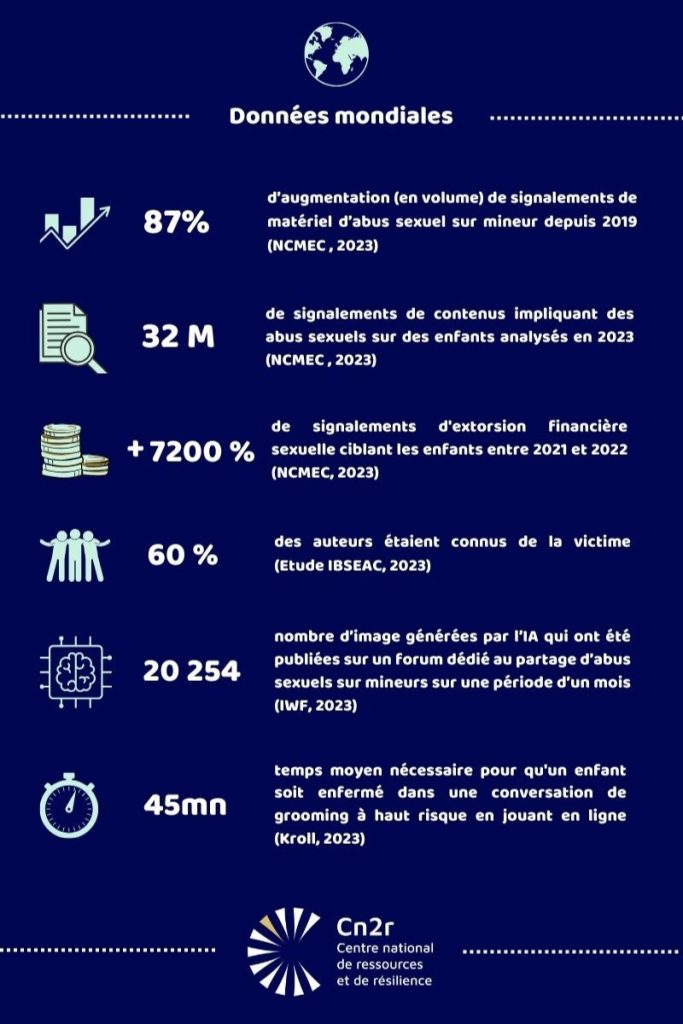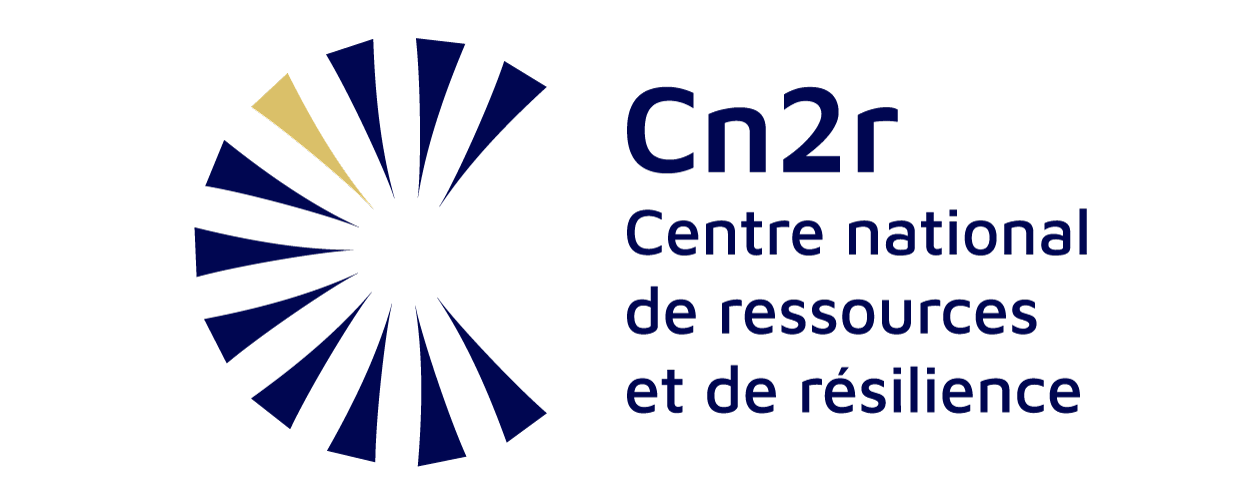Mental health and cybercrime: preventing the psychological risks of child sexual exploitation in a booming digital world
With an 87% increase in reports of online sexual abuse content since 2019, online child sexual exploitation is adapting to technological developments, making these crimes easier to commit. Faced with this growing threat, it is essential to understand not only the scale of the phenomenon, but also its psychological impact on victims in order to develop educational strategies to better protect children.
Playback time: 7 to 9 minutes
Watch: the replay of our webinar on cyberpédocriminalité presented by Véronique Béchu and Diane Salomon from the Office Mineurs.
Contents
A recent Australian survey revealed that 15.1% of Australian men have experienced sexual attraction to children, and 9.4% have committed sexual offences. These alarming figures show just how widespread the problem is, and underline the extent to which the Internet adds a new dimension to this scourge. Indeed, although the Internet may appear anonymous, it is not really, but remains an easily accessible platform for committing these crimes, thus increasing the risks for children.
In this context, online child sexual exploitation and abuse (OCSEA) is an important part of cybercrime. OCSEA covers a wide range of offences facilitated by technology. These include the production, distribution and possession of child sexual exploitation material (CSEM), online grooming (luring a minor into confidence and then soliciting him or her for sexual purposes), sexting (sharing sexual content), sextortion (sexual blackmail) and revenge porn.
OCSEA also encompasses the commercial sexual exploitation of children, including through online prostitution, and livestreaming of sexual abuse, which enables the production and real-time broadcast of these acts. WeProtect Global Alliance 's "Global Threat Assessment 2023" report highlights an 87% increase in reports of online sexual abuse content since 2019. New digital technologies, particularly the development of artificial intelligence (AI), are making it easier than ever for criminals to create and disseminate abusive content.
An explosion in online sexual abuse of minors
WeProtect's report highlights that in 2022, the US-founded National Center for Missing & Exploited Children (NCMEC) received over 32 million reports of child sexual abuse content online, an 87% increase since 2019. Abuse comes in many forms: coercion to produce abusive content (often linked to recorded acts of rape to produce child pornography), financial sextortion, AI-generated images.
The authors of the report warn that emerging technologies such as extended reality (XR) and generative AI present risks for child safety. They are used by predators to create abusive content from scratch, but also to avoid detection.

Real psychological repercussions
Although these crimes take place in an immaterial environment, the damage they cause to the mental health of victims of online sexual abuse is very real. Children affected by OCSEA, whether victims of sextortion or coerced into producing child pornography content - often perpetrated in the context of intrafamilial abuse, particularly incestuous abuse - experience relational difficulties, experiencing problems in establishing and maintaining intimate and friendly relationships, due to the betrayal and manipulation they have suffered. Depression, anxiety, self-harm, suicidal ideation, shame and guilt are all direct consequences ofOCSEA's actions.
Many of these children develop post-traumatic stress disorder, the effects of which are accentuated by the permanence of online images of their abuse. The possibility of these images being seen by an unknown audience, at any time, reinforces their sense of insecurity and continuous exposure, compounding their psychological distress. The constant fear that these images will be shared or reused adds a further traumatic dimension, creating a vicious circle of revictimization that further complicates their recovery process.
The weight of shame after sexual abuse
In particular, it is believed that "shame following sexual abuse contributes to intrusions (such as nightmares, flashbacks and intrusive thoughts) and also explains the relationships between such abuse, depression, bulimia, future family conflict and revictimization ". It also "predisposes individuals to develop post-traumatic stress disorder in response to further trauma, and is closely linked to the development of dissociation".
Shame and guilt reinforce the fear of revealing abuse, often leading to social isolation and difficulty in seeking help. These emotions can also trigger panic attacks, sleep disorders and concentration problems, exacerbating the psychological suffering of victims. In the context of OCSEA, although specific research is still in development, it is plausible to think that the persistent fear of the images being disseminated and the resulting social stigma may accentuate these feelings of shame and guilt, creating a vicious circle of psychological distress.
Insufficient documentation in the judicial context
Research also shows that the mental health of victims of online sexual abuse is often overlooked in legal documents. This was revealed in an analysis of 98 Swedish judgments handed down between 2016 and 2020, where the mental health of child victims, particularly those subjected to acts such as sextortion or incitement to produce sexual content, was only mentioned in less than half of cases.
Psychological health was mentioned in only 48% of cases, and more frequently in cases combining online and offline abuse (76.5%) than online abuse alone (42%).
Pre-existing vulnerability factors
Furthermore, the same Swedish study highlighted various vulnerability factors among child victims of online sexual abuse, underlining the need to fully integrate them into the analysis of judicial files.
- Individual vulnerabilities: Some children have psychological fragilities or cognitive deficits that increase their susceptibility to online predation. One study revealed that pre-existing psychological fragility was found in 16.3% of cases prior to abuse.
- Psychological disorders: Victims of sextortion or enticement to produce sexual content online may suffer from depression, anxiety disorders or post-traumatic stress symptoms, all of which put them at greater risk online.
- Cognitive impairments: Cognitive delays or intellectual deficiencies may be present, making children more vulnerable to manipulation by predators, especially in contexts where they are encouraged to participate actively in sexual acts.
- Unfavorable relational context: Social and family interactions play a key role in children's vulnerability. A poor relational environment amplifies the risk of online abuse.
- Social isolation: Many child victims, especially those targeted by online predators, find themselves in a situation of isolation, often reinforced by a lack of family or educational support.
- Stressful environments: Domestic violence or school bullying are aggravating factors that increase children's receptiveness to the solicitations of online aggressors.
- Self-destructive behaviours: Some children display self-destructive behaviours even before they become victims of abuse, underscoring the urgent need for preventive intervention.
- Self-mutilation and suicidal ideation: These behaviors reflect deep malaise and can make children particularly vulnerable to malicious online interactions, such as sextortion, where they feel compelled to submit to the aggressor's demands.
The case of livestreaming
Livestreaming technology has introduced a new dimension to online child sexual abuse and exploitation. Research conducted by Catharina Drejer, a researcher at Oslo Metropolitan University, reveals that the majority of victims of this abuse are girls aged between 7 and 17. Often, these children are manipulated by those closest to them, including members of their family or local community, into taking part in a live broadcast in exchange for money.

The COVID-19 pandemic has exacerbated this situation, leading to a notable increase in cases of so-called "Livestreaming Child Sexual Abuse" (LSCSA), due to the increased use of livestreaming services such as Facebook Live, Zoom and other social platforms. Abuse is facilitated by criminals who exploit these technologies to broadcast abuse live, often solicited by remote predators who pay for these services via anonymous money transfer systems. The psychological consequences for the victims of these acts are severe, with a high risk of revictimization due to the continuous dissemination of images of their sexual exploitation on the web.
Legal and technological obstacles
From a legal and technological point of view, several obstacles make the prosecution of these crimes particularly difficult. Firstly, livestreaming of child sexual abuse lacks a clear legal definition, and is not always treated as a separate offence in many national legislations. This legal vacuum often prevents effective prosecution of the perpetrators, especially as the lack of harmonization of laws at international level, notably due to differences in the interpretation of laws between countries, complicates judicial cooperation at international level.
To overcome these obstacles, progress is needed both in terms of international laws and detection technologies, notably by developing more advanced methods for monitoring, identifying and prosecuting criminals while respecting personal data protection frameworks.
Educational interventions to prevent online sexual abuse
As children's access to the Internet increases, so do the risks of sexual solicitation, online harassment and exposure to pornography. In this context, educational programs play a decisive role in improving online safety for minors. Online educational games, for example, capture their attention and reinforce knowledge retention. However, it remains difficult to change risky behavior.

Some studies even show an increase in risky behavior after certain interventions, probably due to heightened curiosity about the subjects addressed. Nevertheless, some programs are proving promising. One example is the Cross-Age Teaching Zone (CATZ) program developed in England at the University of Chester. In this program, older children pass on online safety knowledge to younger ones, such as recognizing risks and strategies for avoiding them. The skills passed on include not only identifying malicious people, but also privacy management, protection against cyber-stalking and computer viruses.
Results? Participants who completed the program showed improved retention of information, both among older tutors and younger students. Not only did they acquire essential online safety skills, but they also showed genuine enthusiasm for learning from their peers. Also, the active involvement of older students as tutors reinforces their own understanding of online risks while raising awareness among younger students.
The education of parents and professionals working with children is also essential. Initiatives such as " Stop It Now! " in the U.S. and the U.K. show that boosting adults' knowledge and confidence can also help protect children.
A systemic approach to effective prevention
To increase the effectiveness of prevention, it is essential to adopt an approach that involves not only children, but also parents, teachers and local players such as associations and authorities. Adopting such an approach enables us to better target several aspects: children's online behaviors, such as sharing personal information or their interactions with strangers, their attitudes to digital risks and their awareness of the dangers, as well as their knowledge of protection tools, such as managing privacy settings or reporting inappropriate behavior.
By integrating elements of their digital culture, these interventions become more relevant and effective". Integrating technology into educational programs can also make learning more interactive and relevant. This is evidenced by a survey conducted by Hartikainen and colleagues in 2019, which showed that children respond positively when interventions incorporate aspects of their own digital culture, such as their media and technology use habits and preferences.
A public health approach to effective prevention
The WeProtect report recommends adopting a public health approach to better understand, prevent and treat online sexual abuse. Inspired by responses to other pressing global issues, this approach focuses on preventing abuse and dealing with the psychological consequences.
The World Health Organization (WHO) summarizes the four key stages of a public health approach to understanding and preventing violence:
- Define and monitor the problem: Collect and analyze data to understand the extent and nature of online sexual abuse.
- Identify the causes of the problem: Examine the risk and protective factors that influence the likelihood of abuse.
- Design, implement and evaluate interventions : Develop and test interventions to prevent abuse and support victims.
- Intensify effective interventions: Widely deploy interventions that have proven their effectiveness, while continuing to evaluate them to ensure continuous improvement.
The conclusions of the global report are clear: interventions must include child-centered approaches to minimize retraumatization and improve access to support structures. As well as preventing abuse before it occurs, efforts must target adequate support for victims to mitigate long-term traumatic effects and enable them to rebuild their lives.



